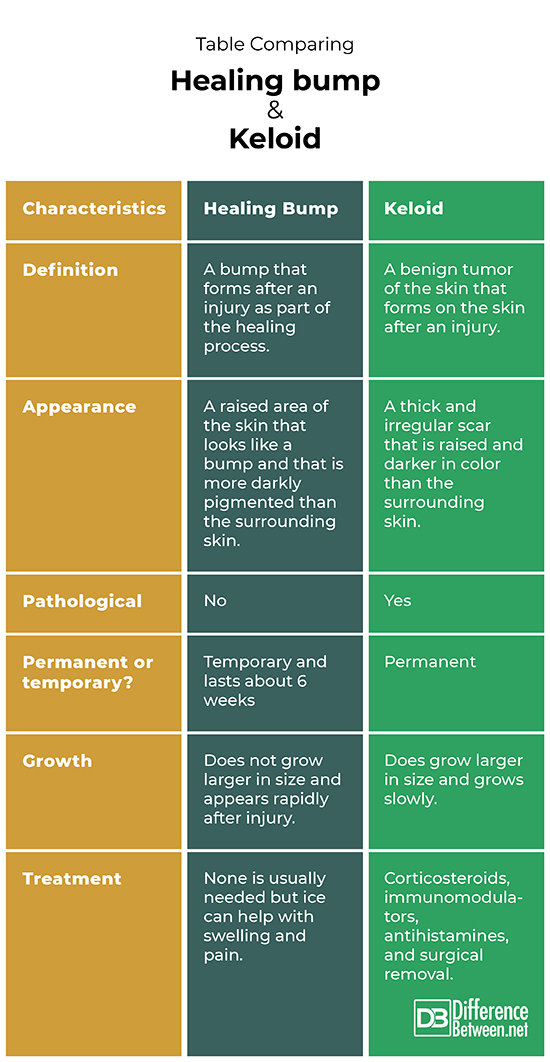Difference Between Healing Bump and Keloid
A healing bump is a lump that is produced on the skin in response to some injury. A keloid is a type of tumor that is benign and can be produced after an injury.

What is a Healing bump?
Definition:
A healing bump is a raised area of skin that is created during the healing process due to inflammation.
Causes:
A healing bump is the body’s natural inflammatory response to an injury. A piercing or any type of wound to the skin will result in a healing bump.
Symptoms:
There may be a pain at the site along with some bleeding and edema (swelling). These will resolve in time as healing completes.
Complications:
A wound can become infected so if a bump starts to ooze pus or hurts more than usual, a doctor should be consulted.
Diagnosis:
A healing bump is identified by appearance and if you have had a history of an injury to the site.
Treatment:
No treatment is needed for a healing bump because this is a part of the normal body response to an injury.

What is Keloid?
Definition:
A keloid is a type of benign tumor of scar tissue that develops after an injury.
Causes:
Keloids result from an overproduction of collagen. Most times keloids happen because a person has suffered injuries such as a cut or even a bite wound from an animal. However, there are cases where the spontaneous occurrence of keloids occurs. Piercings, burns, or even having a condition such as chickenpox or acne can produce keloids. Surgical incisions may also develop into keloids.
Symptoms:
A keloid appears as a raised area of skin that is darker in color than the surrounding skin. The area also has a jagged irregular edge and appearance. Pain, bleeding, and itching of keloids can occur.
Complications:
A keloid could become infected but the most common problem is that the person feels self-conscious since it affects their appearance. It thus causes psychological distress especially if on the face.
Diagnosis:
The clinical appearance of the keloid is normally how a diagnosis is made. If uncertain, doctors can biopsy a growth to make sure it is not a cancerous tumor.
Treatment:
There are some things that can be done to treat keloids. The area of the skin can be cut out or removed by laser or cryotherapy. Corticosteroids, immunomodulators, and antihistamines can help reduce the swelling and appearance of the keloids. Keloids are a challenge to treat because they often occur again.
Difference between Healing bump and Keloid?
Definition
A healing bump is a raised area that forms after an injury as part of the healing process. A keloid is a benign tumor that forms on the skin after an injury.
Appearance
The appearance of a healing bump is a raised darker colored area of skin. The appearance of a keloid is a thick and irregular scar on the skin that is raised from and darker than the surrounding skin.
Pathological
A healing bump is not pathological and is a natural part of the healing process. A keloid is pathological because it is due to too much collagen being deposited, leaving a scar.
Permanent or temporary?
A healing bump is temporary and lasts up to 6 weeks. A keloid is permanent and even if removed, usually returns.
Growth
A feature of a healing bump is that it doesn’t grow large in size and it appears soon after an injury happens. A feature of a keloid is that does grow bigger and is slow to form.
Treatment
Usually, no treatment is needed for a healing bump but ice can be used to help with swelling. Treatment for a keloid is challenging and often they return; however surgical removal, and the use of corticosteroids and immunomodulators can be helpful.
Table comparing Healing bump and Keloid

Summary of Healing bump Vs. Keloid
- A healing bump is a normal occurrence after any type of injury.
- A keloid is not normal, is difficult to treat, and is often a permanent problem.
- A healing bump and keloid are both noticed as raised areas of skin that result from an injury.
FAQ
Can piercing bumps turn into keloids?
In time, it is possible for a piercing bump to become a keloid.
What is a healing bump?
A healing bump is a normal lump that forms due to an injury. The bump, in time, will resolve as the healing process is completed.
Will a piercing bump go away?
Yes, a piercing bump or healing bump will heal and disappear after a month or two.
When do keloids appear on piercings?
They can appear any time from 6 to 12 months after a piercing and are known to occur in about half of all first-time piercings.
How do you know if it’s a piercing bump or keloid?
A piercing bump will improve in time while a keloid will not. Also, a keloid develops much more slowly taking several months to form.
Can keloids go away naturally?
No, keloids do not go away on their own.
What causes keloids after piercing?
Occasionally, excess car tissue forms after a piercing. This can result in the formation of a keloid.
- Difference Between Rumination and Regurgitation - June 13, 2024
- Difference Between Pyelectasis and Hydronephrosis - June 4, 2024
- Difference Between Cellulitis and Erysipelas - June 1, 2024
Search DifferenceBetween.net :
Leave a Response
References :
[0]Aaron, Denise M. “Keloids”. Merckmanuals. Merck & Co., 2022, https://www.msdmanuals.com/professional/dermatologic-disorders/reactions-to-sunlight/overview-of-effects-of-sunlight
[1]Chike-Obi, Chuma J., Patrick D. Cole, and Anthony E. Brissett. "Keloids: pathogenesis, clinical features, and management." Seminars in plastic surgery. Vol. 23. No. 03. © Thieme Medical Publishers, 2009.
[2]Metts, Julius. "Common complications of body piercing." Western journal of medicine 176.2 (2002): 85.
